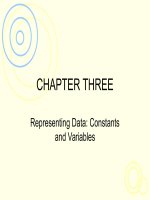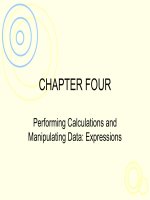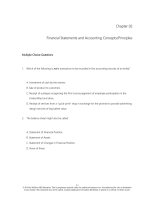Lecture Accounting: What the numbers mean (5/e) - Chapter 4: The bookkeeping process and transaction analysis
Bạn đang xem bản rút gọn của tài liệu. Xem và tải ngay bản đầy đủ của tài liệu tại đây (152.39 KB, 30 trang )
CHAPTER 4
THE BOOKKEEPING
PROCESS AND
TRANSACTION
ANALYSIS
McGrawHill/Irwin
©The McGrawHill Companies, Inc., 2002
Learning Objectives
1.
2.
3.
4.
How can the basic accounting equation be
expanded to include revenues and
expenses?
How does the expanded accounting
equation stay in balance after every
transaction?
How is the income statement linked to the
balance sheet through owners’ equity?
What are the meanings of the terms
journal, ledger, T-account, account
balance, debit, credit, and closing the
books?
McGrawHill/Irwin
©The McGrawHill Companies, Inc., 2002
Learning Objectives
5.
6.
7.
How is the bookkeeping system a
mechanical adaptation of the
expanded accounting equation?
How is a transaction analyzed, how
is a journal entry prepared, and
how is the effect of a transaction
on working capital determined?
What are the five questions of
transaction analysis?
McGrawHill/Irwin
©The McGrawHill Companies, Inc., 2002
Learning Objective 1
•
How can the basic accounting
equation be expanded to
include revenues and
expenses?
McGrawHill/Irwin
©The McGrawHill Companies, Inc., 2002
Bookkeeping/Accounting
Process
•
The process begins with transactions
•
The transactions are reflected in the financial
statements
•
One must know the mechanical process to
understand the effects of transactions on the
financial statements
McGrawHill/Irwin
©The McGrawHill Companies, Inc., 2002
The Balance Sheet Equations
•
The basic equation is:
Assets = Liabilities + Owners’ Equity
•
Since Owners’ Equity consists of PaidIn Capital and Retained Earnings, the
equation can be restated as:
•
Assets = Liabilities + (Paid-In Capital +
Retained Earnings)
McGrawHill/Irwin
©The McGrawHill Companies, Inc., 2002
The Balance Sheet Equations
•
Since Retained Earnings is computed
as Beginning Retained Earnings plus
Revenues and less Expenses, the
basic equation can be restated as:
Assets = Liabilities + (Paid-In Capital +
Beginning Retained Earnings +
Revenues – Expenses)
McGrawHill/Irwin
©The McGrawHill Companies, Inc., 2002
Learning Objective 2
•
How does the expanded
accounting equation stay in
balance after every
transaction?
McGrawHill/Irwin
©The McGrawHill Companies, Inc., 2002
EXHIBIT 4-1
Transaction Summary
ASSETS
LIABILITIES
Accounts Merchandise
Notes
Accounts Paid-In
Transaction Cash
Receivable Inventory
Equipment Payable Payable Capital
1.
+30
+30
2.
-25
+25
3.
+15
+15
4.
-10
+20
+10
5.
+2
+5
-7
6.
+5
-5
Total
17
0
20
18
15
10
30
7.
Revenues
+20
7.
Expenses
20
-12
8.
+3
Total
17
20
8
18
15
13
30
OWNERS' EQUITY
Retained
Earnings Revenue Expenses
+20
+20
-12
-3
-15
+5
McGrawHill/Irwin
©The McGrawHill Companies, Inc., 2002
Learning Objective 3
•
How is the income statement
linked to the balance sheet
through owners’ equity?
McGrawHill/Irwin
©The McGrawHill Companies, Inc., 2002
Linking the Income Statement
and the Balance Sheet
•
The Net Income on the Income Statement
gets into the Balance Sheet through the
Retained Earnings section of Owners’
Equity
•
See the previous slide for an example
McGrawHill/Irwin
©The McGrawHill Companies, Inc., 2002
Learning Objective 4
•
What are the meanings of the
terms journal, ledger, T-account,
account balance, debit, credit,
and closing the books?
McGrawHill/Irwin
©The McGrawHill Companies, Inc., 2002
Bookkeeping Jargon and
Procedures
•
•
•
•
•
•
•
Journal – where transactions are initially
recorded
Post – to record
Ledger – a set of accounts for each category of
asset, liability, and owners’ equity
Chart of accounts – an index to the ledger
T-Account – an account format that looks like a
“T.” One side indicates an addition; the other a
subtraction from the account
Debit – the left side
Credit – the right side
McGrawHill/Irwin
©The McGrawHill Companies, Inc., 2002
Learning Objective 5
•
How is the bookkeeping system
a mechanical adaptation of the
expanded accounting equation?
McGrawHill/Irwin
©The McGrawHill Companies, Inc., 2002
The Bookkeeping System
•
•
•
•
Debits must always equal credits
Asset accounts will normally have
debit balances
Increases in assets are entered as debits;
decreases are entered as credits
Liabilities and Owners’ Equity are the
opposite of Assets. Debits are decreases
and credits are increases
McGrawHill/Irwin
©The McGrawHill Companies, Inc., 2002
Journal Entries
•
•
The journal is the book of original entry
The format for a journal entry is as follows:
Date
•
•
•
Dr. Account name Amount
Cr. Account name
Amount
Note the date is entered for reference
Dr. and Cr. are used for debit and credit
A journal entry may have more than one
debit and more than one credit
McGrawHill/Irwin
©The McGrawHill Companies, Inc., 2002
Learning Objective 6
•
How is a transaction analyzed, how
is a journal entry prepared, and how
is the effect of a transaction on the
financial statements determined?
McGrawHill/Irwin
©The McGrawHill Companies, Inc., 2002
Transaction Effects - Balance Sheet
•
The horizontal model is an alternative to using Taccounts and journal entries
•
The model is as follows:
Balance Sheet
Income Statement
Assets = Liabilities + Owners’ Equity
Net Income = Revenues – Expenses
(Accounts and amounts affected by transactions
are entered under the appropriate categories)
McGrawHill/Irwin
©The McGrawHill Companies, Inc., 2002
Adjusting Entries
•
Made to reflect accrual accounting in the
financial statements
•
Results in revenues and expenses being
reported in the appropriate fiscal period
•
Two types of adjusting entries
• Accruals
• Reclassifications
McGrawHill/Irwin
©The McGrawHill Companies, Inc., 2002
Accruals and Reclassifications
•
Accruals- transactions for which cash
has not yet been received or paid, but
revenues and expenses need to be
matched
•
Reclassifications – the initial recording
of a transaction must be reclassified to
reflect when revenues were earned or
when expenses were incurred
McGrawHill/Irwin
©The McGrawHill Companies, Inc., 2002
Accruals
•
Example: Work performed by
employees in March, but paid in April
•
At the end of March debit Wages
Expense and credit Wages Payable
•
Example: Interest earned in March, but
not received
•
At the end of March debit Interest
Receivable and credit Interest Revenue
McGrawHill/Irwin
©The McGrawHill Companies, Inc., 2002
Reclassifications
•
Example: Supplies are purchased in February
and are recorded as an asset. Then the
supplies are used.
•
The expense Supplies Expense should be
debited and the asset Supplies should be
credited for the amount of supplies used
•
If the purchased supplies were debited to
Supplies Expense when purchased, the unused
supplies should be debited to the asset account
and the Supplies Expense account should be
credited
McGrawHill/Irwin
©The McGrawHill Companies, Inc., 2002
Adjusting Entries Revisited
•
Generally, every adjusting entry affects
both the Balance Sheet and the
Income Statement
•
After the adjusting entries have been
made, the account balances are
determined, and the financial
statements are prepared
McGrawHill/Irwin
©The McGrawHill Companies, Inc., 2002
Learning Objective 7
•
What are the five questions of
transaction analysis?
McGrawHill/Irwin
©The McGrawHill Companies, Inc., 2002
Five Transaction Analysis
Questions
•
•
•
•
•
What’s going on?
What accounts are affected?
How are they affected?
Does the Balance Sheet balance?
(Do the debits equal the credits?)
Does my analysis make
sense?
McGrawHill/Irwin
©The McGrawHill Companies, Inc., 2002









